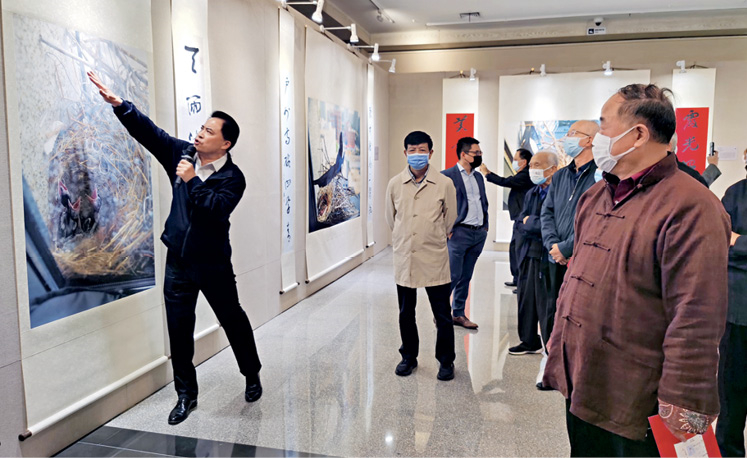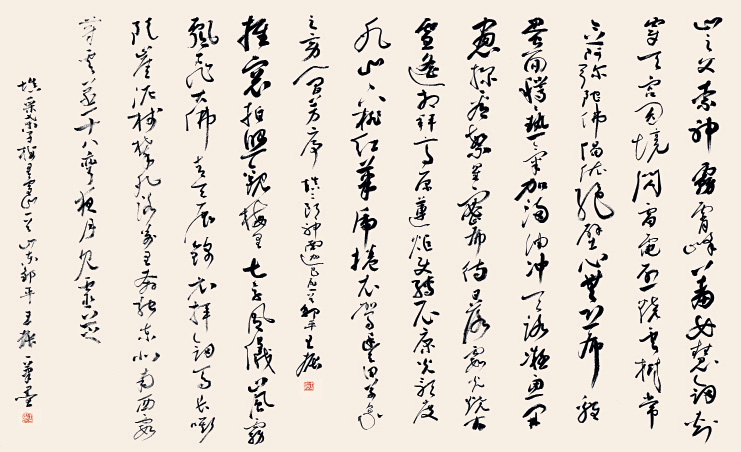“Learning calligraphy, first of all, is about inheritance, and every stroke should have a source as calligraphy is like dancing in shackles, and innovation without inheritance is worthless.”

Wang Zhen (left) and Mo Yan (right) at Wang’s calligraphy exhibition vividly showcasing the story of Wang and the magpies through over 110 calligraphy and photographic works.
After finding a magpie nest on the windowsill of his studio in February 2014, calligrapher Wang Zhen and the magpie family began a wonderful companionship.
Magpie Neighbors
Wang recorded the magpie family’s lives with a set of self-made equipment, which includes a photographic camera, a video camera, and a mini microphone. The arrival of the magpies brought him a lot of inspiration. They build their nest with a well-thought design plan and make the best of materials available. They protect their offspring fearlessly, no matter what challenges and risks they face.
Wang said the magpies’ daily activities fed his aesthetic understanding and thinking about calligraphy.
His calligraphy exhibition, sponsored by the China Wildlife Conservation Association, was held at the Overseas Chinese History Museum of China in Beijing in April 2022. Through more than 110 calligraphy and photographic works, the exhibition showcased the vivid story about Wang and the magpies.
Mo Yan, a Nobel laureate in literature, said in his speech at the exhibition that Wang’s works go beyond the art of calligraphy, to tell a story of animal protection and dedicated love, which enlightens humanity.
Su Shishu, chairman of the Chinese Calligraphers Association, said that Wang is superb in the creation of Shu Style, and has gradually formed his own style. His calligraphic structure is bold and stable, exuding an air of positivity.
According to Wang, after recording the life of the magpies for a long time, he slowly discovered that there was an inextricable connection between the magpie’s movement and his calligraphy. Their movements and postures were often too wonderful for words, he said, adding that calligraphy cannot be divorced from real life and nature.

Calligraphic work by Wang Zhen.
A Holistic Artform
Wang enjoys reciting classics in his daily life. “Fan Zhongyan’s Memorial to Yueyang Tower changed my life,” he said, adding that he grew up listening to the story of Fan (989-1052), a prominent statesman and literary figure of the Northern Song Dynasty (960-1127).
The emotions in Fan’s poem hold a deep attraction for Wang. The classic lines, “Do not rejoice in things, do not grieve with yourself,” and “Being the first to worry about the affairs of the state and the last to enjoy oneself,” have long been engraved in his heart.
The poetry has instilled in him an admiration for Chinese classics for their linguistic mastery, rhythm, and artistic conception. Whether he is feeling happy or worried, he always enjoys reading and reciting the classics, such as The Analects of Confucius and Hard Roads in Sichuan. The devotion to classics has enriched his calligraphy creations.
Wang worked with the calligraphy master Shu Tong for a very long time. “Influenced by my father, my interest in calligraphy began to grow in my childhood, and after working with Shu, I had the unique advantages for learning calligraphy,” Wang said. There were a large number of calligraphy books and rubbings in Shu’s home, which he could read and use at any time. “Amazingly, listening to Shu’s words and watching his actions improved my art of calligraphy day by day,” said Wang. “There should be a writing brush in the heart,” he said, recalling what he learned from Master Shu. “Before writing, you [get to] know the appearance of the characters [needed], and then prepare the ink with confidence.”
“For a person with poor moral quality, it is useless no matter how well he writes. Grinding ink is cultivating one’s moral character,” Shu told Wang. Practicing calligraphy is the process of observing the world, and creating work is to shape personality. “Handwriting can reflect a man and his personality, and vice versa.”
Shu also taught Wang to create his own works of writings. The purpose of practicing calligraphy, reciting classics, and strengthening self-cultivation is to create works of your own. “Calligraphy without literary content is still technique, and the core value of calligraphy art is to write one’s own words and express one’s emotions,” advised Shu.
Apart from being a member of the Chinese Calligraphers Association, Wang is also president of the Beijing Shutong Culture and Art Research Association and editor-in-chief of Classic Recitation and Writing. With these platforms, he hopes to pass on his research and understanding of classics and calligraphy to more people.

Calligraphic work by Wang Zhen.
Story of Poetry and Literature
“On New Year’s Day 2021, Mo Yan and I watched the sunrise in Fuyuan County, Heilongjiang Province. The temperature was minus 39 degree Celsius. I sprinked a scoop of boiling water into the air, which immediately froze into ice, Wang recalled. When the sun rose, Mo wrote the two big characters of “Xin Xi” (new sunlight) with a brush dipped in thick ink.
“Mo and I both served in the military and we lived in unique and harsh environments. Finding joy in hardship is our common hobby,” said Wang. In recent years, they have been running a WeChat social media account together, sharing content about poetry and literature.
Essence of Calligraphy
As a traditional cultural treasure, the art of calligraphy is still valued and loved by the Chinese people nowadays. Talking about his understanding of calligraphy aesthetics, Wang said that through daily practicing by copying masters’ works, people can foster affection with brush and ink, and cultivate their moral character.
“Learning calligraphy, first of all, is about inheritance, and every stroke should have a source as calligraphy is like dancing in shackles, and innovation without inheritance is worthless,” said Wang. He believes that calligraphy can be learned by everyone, and everyone who writes Chinese characters has their own aesthetic judgement. “Studying in a down-to-earth approach and finding happiness in learning is the essence and key,” said Wang. 
HAI AO is a media professional.